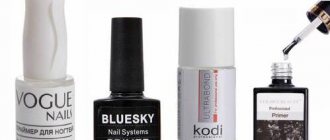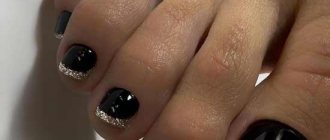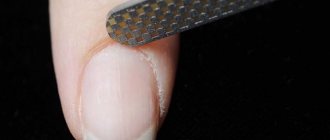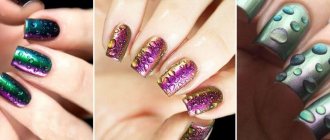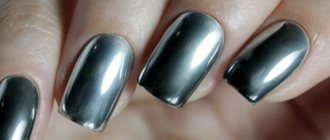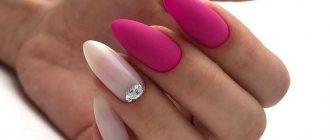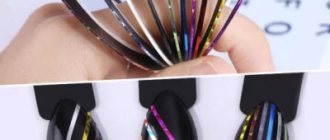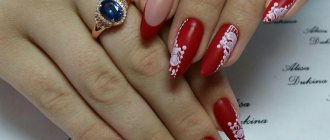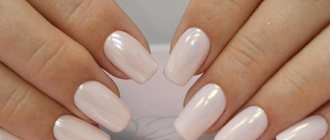A magic wand really does exist, at least in manicure. This is a buff, as everyone affectionately calls it, it is vital if you want to have beautiful, well-groomed hands. A good manicure without a buff is simply impossible; this universal file performs many functions in manicure for natural and extended nails. The right buff and using it according to all the rules will prepare your nails for any luxurious coating. Why do you need a nail buffer, why is it so good, and why should it be in any fashionista’s manicure set? Let’s find out right now.
Using the buff
Advantages of a unique nail file
The secret of the buff is that it is usually a block, each edge of which performs a specific task, and this depends on the different abrasiveness of the edges.
What is each edge needed for?
- the first side is a regular file to create the desired shape of nails, they can be shortened and trimmed;
- the second side is used to remove irregularities on the plate - burrs, roughness;
- a third party sands and removes minor imperfections;
- the fourth side polishes the plates, giving them a natural shine.
What can be replaced
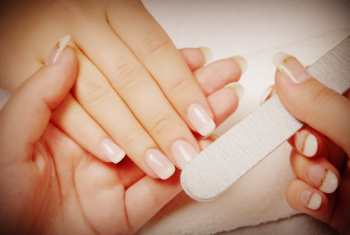
Baf file is a unique nail polishing tool of its own. The appearance was preceded by technical progress in all spheres of human life, including the nail beauty industry. This is a truly necessary detail for a high-quality manicure, which can be done not only in a beauty salon, but also at home.
If you decide to do a manicure yourself without leaving home, and you don’t have a device called a “buff” at hand, then you can use a nail file instead. But the result, of course, will not be the same as after applying the buff.
It happens that you can’t even find a nail file at hand, but it is extremely necessary to polish your nails, try to take at least a hard cloth. The result of such manipulation, of course, cannot be called ideal, but if there is nothing, then at least try to replace the buff this way. Any type of manicure is carried out using grinding materials, it is best if it is a modern and high-quality tool.
Beautiful and well-groomed nails are a necessary element of female beauty and self-confidence. Making a fashionable manicure at home has become much easier with the invention of buffs. You just need to choose the right product, taking into account the structure of your nails, and use it correctly, following all the above tips and recommendations.
Let's look at the main characteristics of buffs
What materials can buffs be made from?
The base is usually made of plastic, wood, silk and other fabrics.
Working surfaces can be:
- polyethylene foam (plastic) - popular, cheap, durable. They can be sterilized;
- silicone can also be washed and disinfected, durable, inexpensive;
- The suede buff may have handles, the quality is average, it is impossible to disinfect;
- a fabric buff is of good quality, suitable for natural nails, elastic, but the cost is higher, especially for a silk-coated buff, and cannot be sterilized.
What is it for?
Depending on the degree of abrasiveness and appearance of the buff, it is used for:
- shaping the nail plate;
- smoothing the surface of the nails;
- polishing to add shine;
- removing remnants of overgrown skin (pterygia);
- grinding the surface to prepare for coating.
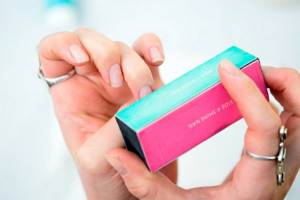
The degree of abrasiveness largely determines the functionality of the buff:
- If you need grinding and polishing of natural nails, take a buffer with an abrasiveness of 300 grit or higher (preferably 400), and for artificial nails 150-200 grit is suitable.
- To correct the shape and length of artificial nails, as well as when working with gel polish coatings, you need a file with an abrasiveness of 100-150 grit. It is also permissible to use such a buff for pedicures if the nail plate is very hard.
- Lower abrasiveness (less than 100 grit) is used only for working with the top layer of artificial turf.
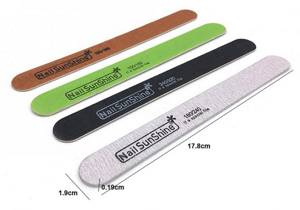
Some files have a recommended method of use on each edge.
When choosing a buff, also pay attention to its size. For manicure, as well as for working with narrow nails, take small elongated files. For pedicures and wide nail plates, wider bars are more suitable.

How to use it correctly
If the buff is used incorrectly, the nail plate may become deformed and pain may appear, so you must adhere to the rules.
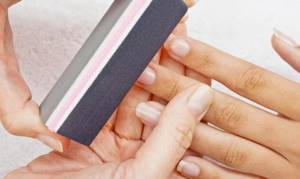
Using the buff
We provide step-by-step instructions on how to use a nail buff when preparing for a manicure:
- apply a buffer to the nail so as to cover the entire surface of the nail plate;
- It is advisable to make a minimum of clicks;
- carefully, in the same direction, make long movements, trying not to stop in the same place;
- you cannot change the direction of movement;
- You cannot constantly use a buff; polishing must be done once a week, otherwise the nail plate will weaken and become fragile;
- The final procedure after polishing is sealing the nails. To do this, add one drop of tea tree oil and spread it over the entire surface of the edge, rubbing lightly. This will prevent your nails from peeling and make them strong;
- The instrument is reusable and requires care and disinfection.
Video
Buff is a multifunctional thing
This tool is actively used by manicure masters. You can also use it at home. The buff is a very useful item for correcting the nail plate.

Salon manicurists most often use disposable nail buffs. They consist of a metal base covered with an abrasive material on both sides.
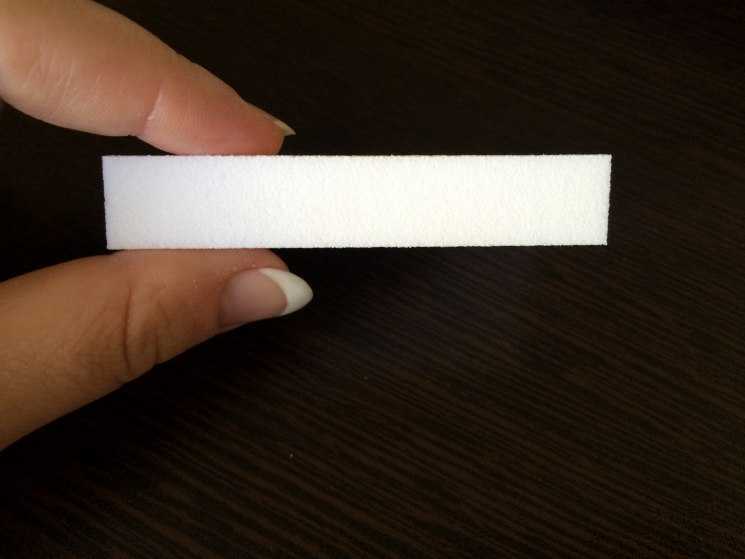
Using disposable buffs is simple and convenient. After polishing and filing the nail, the tool is thrown away.
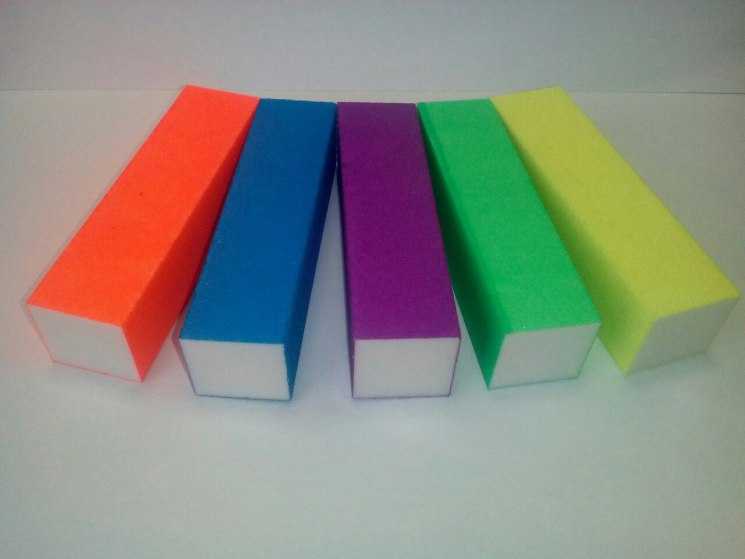
For home use, you can purchase a reusable buff. The main thing is not to forget to regularly disinfect it with standard sterilizers.
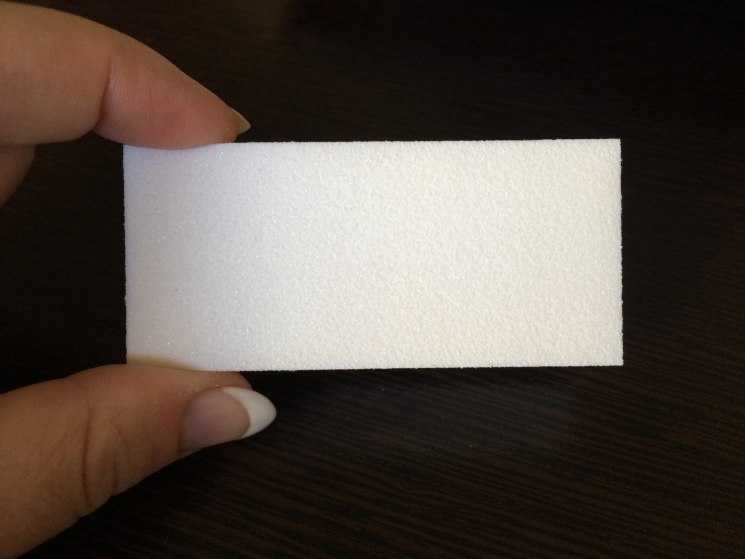
All about abrasiveness
The different functionality of the edges is explained by different degrees of abrasiveness, that is, the size of the grains (pores) on the surface of the buff. Abrasiveness determines the hardness of each edge and is measured in grits. Let's consider the classification of abrasiveness and the functionality of the edges:
- 60-80 gr. These are hard buffs for rough polishing of extended and artificial nails and performing pedicures;
- 100-150 gr. Suitable for correcting extended nails before applying gel polish; you can correct fingernails and toenails extended with acrylic or gel plates;
- 150-240 gr. You can file down natural and artificial nails, file the tips of natural nails, polish artificial nails;
- 300-450 gr. This is a buff for natural nails, for delicate work with them. The grain size is fine, soft polishing of the surface of natural plates is possible.
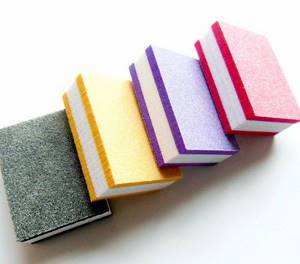
Mini nail buffs
Important. Which buff to choose depends on the purpose of the tool. For thin and weakened nails, a buff with maximum abrasiveness is suitable - above 300 g. The best material is suede, which acts gently and is gentle on nails.
What is a nail buff
A nail buff is a type of file, most often shaped like a bar. Designed for manicure and pedicure, for working with both natural and artificial nails. Typically used for polishing and polishing the nail plate.
There are also buffs shaped like a regular, but very soft file.
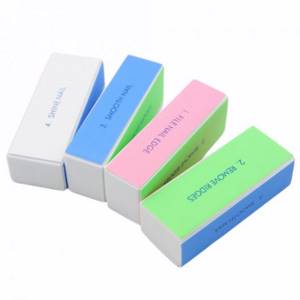
Photo: What a nail buff looks like
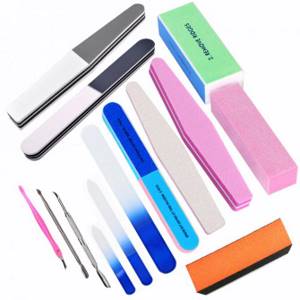
Instrument care
Gradually, dirt and bacteria may accumulate in the bar, so it must be sterilized after each use.
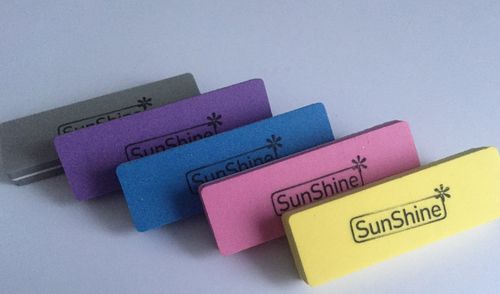
Nail buffs
It is better to choose a tool with easy maintenance:
- fabric products allow water to pass through, so they are simply replaced with new ones, but can be cleaned with a brush soaked in a disinfectant;
- plastic buffs are easy to disinfect and can be washed in a warm soapy solution;
- The ideal option is to purchase several bars with different abrasiveness, from different materials and change as needed; this is an option for those who do not have to save.
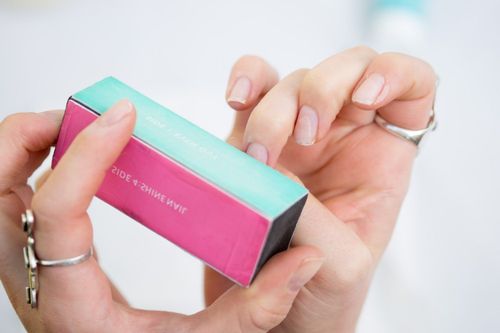
Using a four-way buff
Purpose
This voluminous quadrangular bar can be used to care for natural and false nails. Nail buffs at home are used comprehensively for:
- grinding;
- polishing;
- giving shape.

You may be interested in:Burgundy manicure: fashion trends, color combinations, photos
With the help of such a block, you can easily remove small irregularities and flaws. This is very important before a multi-layer extension procedure, as well as applying varnish or gel. The working surfaces of the nail buffs are numbered, which helps you understand which side needs to be applied. The numbered sides indicate the function being performed, using:
- 1 side of the nail is given the desired shape and is also used for shortening;
- 2 – remove burrs and get rid of irregularities;
- 3 – grind, remove roughness;
- 4 – polish nails to shine.
Alternative
Buff is not sold on every shelf in every store, however, it is better to find and purchase it, since there is simply nothing to replace it. A buff and a nail file differ in the quality of processing; a simple file has a rather low quality. If, nevertheless, there is an urgent need for a manicure, but there is no buff, the solution is as follows:
- any file with an abrasiveness of more than 300 gr. can help out temporarily;
- polishing, elimination of defects and irregularities can be done with any rough material, for example a piece of rough, harsh fabric.
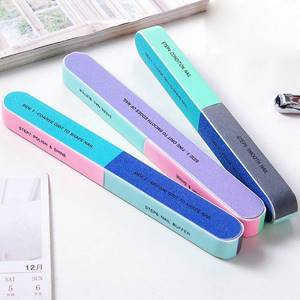
Nail file buff
Results. A good quality buff will help to thoroughly polish your nails for gel polish coating; it will lie firmly on the nail. The life of the gel polish will be significantly extended, but you need to take into account the condition of the nail plates - if they are thin, you need to choose a softer buff.
a brief description of
A buff for polishing nails is a special file in the shape of a three-dimensional rectangle. Its main purpose is to polish nails; it is used as a polishing agent for natural and artificial nail extensions.
Literally “buff” is translated as “polishing” (English), the name corresponds to its purpose. The importance of such a tool cannot be underestimated, because the success of the entire procedure, be it extensions, gel coating, or even regular varnish, depends on a well-polished manicure. The smoother and neater the nail plate is, the more beautiful and durable the final result of the manipulation will be. Using this device, unevenness and roughness of the plates are removed.
A product called “buff” can be used for polishing both at home and in professional beauty salons. Such products are made from all kinds of materials. In salons, such items are used one-time, or maybe more than once, if the material used to make the instrument is subject to treatment with disinfectants.
Marking different sides of buffs
The markings of the edges on the manicure buff are indicated by numbers. Some manufacturers prefer not to use numbers, but to indicate the difference with a color expression. For example, the side for processing before coating and surface correction is gray. The second, designed to remove rough transitions, is painted pink. The third is blue, and the fourth is white.
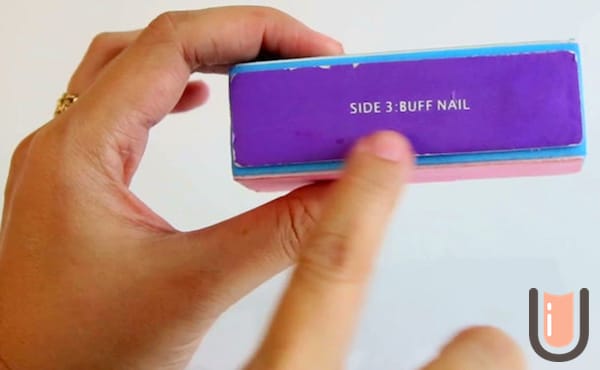
There are two-color nail polishing bars. Accordingly, such a block has two working sides for grinding and two for polishing.
What does nail polishing involve?
Nail polishing is the process of eliminating roughness and various grooves that appear on the surface of the nails. As a result, the nails become smooth and the polish is applied evenly. But thanks to this procedure, the nail plate itself begins to grow better due to the fact that the blood vessels are stimulated. And along with the stratum corneum, bacteria that usually cause nail infections are removed from the surface of the nail.
When is nail polishing necessary? Typically, such a procedure is not done always, whenever it pleases, but only in some cases:
- if the nail contains remnants of old varnish;
- if the nails are not too smooth, with tubercles;
- the nail plate has lost its former shine.
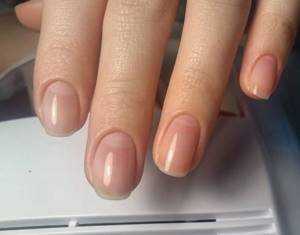
Price
Choosing buffs wholesale or retail is not a problem now. Moscow stores offer a wide range of manicure tools from different brands. If the prices in stationary retail outlets seem high to you, then turn your attention to online stores, where sanding blocks at a more affordable price can be easily selected from the photo.
| Brand name | Average cost of buffs (region – Moscow) |
| Dead Sea Premier | 300 rub. |
| Buff Zinger | 120 rub. |
| Salon Professional | 100-250 rub. |
Conclusion
A manicure buff is a necessary tool for giving your nails the desired shape and smooth surface. The bar will also be indispensable for lovers of natural manicure, in which the plate will look beautiful and well-groomed even without coating.
If you want to visually study the process of working with a buff, the video in this article will help you, and if you have any questions, you can ask them in the comments.
Did you like the article? Subscribe to our Yandex.Zen channel
Text \ Photo Victoria BOLSHOVA Posted 07/30/2018
0
share:
To favorites
To print
If you want to thank, add clarification or objection to the author - add a comment!
Currently being discussed:
- Lyubov Burkina
20.08.2018
What hair color should I choose? Please give me some advice. I don't know which one I have...
- I
19.08.2018
I had eyelash extensions for 6 months and took a break. After 3 months I increased it again...
- Vasilisa
18.08.2018
Cool hairstyle
18.08.2018
Hi, can I dye my bleached hair (currently red) bright purple...
16.08.2018
Hello! I am a dark girl with black eyes. I want to dye my hair dark...
15.08.2018
The photo shows young beauties. Can older ladies have their eyebrows done? Age...
Comments »
Bafik prepares a plate for a manicure
When magnified, even healthy plates have alternating longitudinal grooves and ridges. This is the structure of a natural nail: it is a lamellar horny formation, an appendage of the skin. In anatomy this is the norm, but in manicure it is a great evil. Gel polishes will not lie flat on such a base, and the extensions will not last long.
Therefore, nail plates must be polished for a complex manicure. That's why you need a nail buffer - a professional tool levels surfaces and improves adhesion to gels and gel polishes.
Material of manufacture
A buff is a type of manicure device for the manufacture of which different materials are used. Depending on this, they have different abrasiveness. This also affects the type of procedure and care for different types of nails.
The first was an accessory made of suede. Nowadays, these manicure blocks are produced on different bases. All varieties of such polishing files existing today have a different base on which the abrasive surface is applied.
One of the most flexible and expensive is a fabric flexible buff. The most common, often used in work is considered to be an inexpensive plastic tool that is convenient to work with and does not vibrate during operation. Foam-polyethylene bars are distinguished by increased wear resistance and softness. They are very easy to disinfect.
Besides chamois nail buffs, there are many varieties of these polishing files. They all have a different base onto which the abrasive surface is directly applied.

Basic rules of use
The purpose of the tool explains the specifics of how to use a nail buff. They need to work according to the following rules:
- Apply the side of this file to the plate with a wide edge, trying to process a large area at a time.
- There shouldn't be a lot of fast movements.
- The direction of movement should be one-sided: from base to tip.
- It should be used no more than once every 7-10 days, since constant polishing with a buff can noticeably thin the plate and make it brittle.
- To prevent lamination, you can use this polishing tool as a material for applying essential oil. It is enough to drop a small drop of tea tree oil onto the plate and spread it as a buffer over the surface, thereby sealing the nail.
These rules allow you to understand how to buff a nail correctly. Following them will help keep your manicure in perfect condition so that your nails remain healthy and well-groomed.
How to polish your nails at home?
In order to polish your nails, you need to stock up on special tools. Usually, for this purpose, they buy files made of smooth mineral, but as for the abrasive coating, it can be sapphire or diamond.
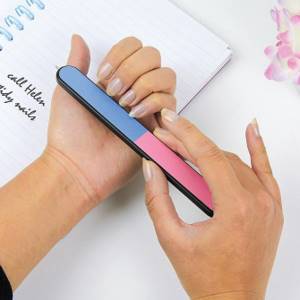
Various cardboard files are also actively used, the abrasive coating of which is fine. They usually have three working surfaces:
- pink - for initial sanding;
- white - in order to smooth out all remaining unevenness;
- gray - to give a glossy shine.
You also need a paper file. Before work, it should be treated with a special alcohol solution. The procedure itself does not constitute
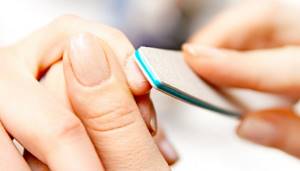
special difficulty:
- First, wash your hands with soap.
- Then they take a pink-coated file and sand, carefully, from the cuticle to the edge of each nail. As a result, the nail plate will become rough.
- After this, the nail is polished with a white file. In this case, shine will appear and the nail plate will become smooth.
- After this procedure, I wash my hands again to remove dust.
- The next step can be considered polishing the nail plate with a gray nail file. Your nails will shine even better.
- Then you need to apply a special treatment that strengthens and restores the nails.
You can also use an electric nail file. The set of this tool includes three different attachments, the degrees of abrasiveness of which differ:

- corrects;
- polishes;
- polishes.
This device runs on batteries, and you can choose the most suitable speed for processing. The algorithm of actions is the same if ordinary files were used as a grinder.
There is also a special device for polishing nails. In another way, this device is called a manual milling cutter. It has several types of attachments that easily glide over the surface of the nail,
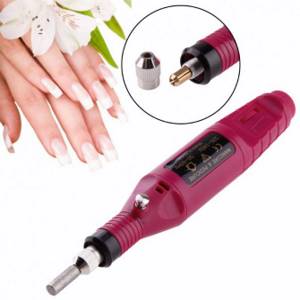
without injuring him. The main thing is to ensure that the speed is optimal. You shouldn’t put too much pressure on the nail plate; if necessary, you can do it several times. But usually once is enough.
Which buff to choose for manicure
The nail sanding tool should be marked 180/240 grit and be less harsh to the touch. If we are talking about a grinder who removes gloss and corrects the nail edge, then it is better to give preference to a number marked 180 grit.
The number 150 will help remove unevenness after shellac. But each time you file the surface, make sure that the spraying does not damage the natural epidermis. Often, polishing files are purchased as a set for one-sided blocks.
Buffs in their general essence
In order to achieve the perfect manicure, you need to use professional and high-quality equipment. In addition to ordinary nail files, every girl’s manicure set should contain a buff.
So what is a buff? The word is borrowed from English. The literal translation means “to polish.” Not many people now know what a nail buff is, because this newfangled file has come into our everyday life quite recently. Let's take a closer look at this issue.
A buff is a certain type of nail file made in the shape of a parallelepiped. Both natural and extended nails are treated with buff.
